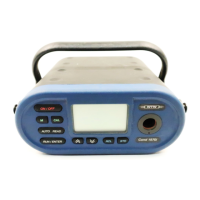Lists Multi 197i
80
ba75339e04 07/2009
Glossary
Adjusting To manipulate a measuring system so that the relevant value (e. g. the
displayed value) differs as little as possible from the correct value or
a value that is regarded as correct, or that the difference remains with-
in the tolerance.
Asymmetry Designation for the offset potential of a pH electrode. It is the measur-
able potential of a symmetrical electrode, the membrane of which is
immersed in a solution with the pH of the nominal electrode zero point
(WTW electrodes: pH = 7).
AutoRange Name of the automatic selection of the measuring range.
AutoRead WTW name for a function to check the stability of the measured value.
Calibration Comparing the value from a measuring system (e. g. the displayed
value) to the correct value or a value that is regarded as correct. Of-
ten, this expression is also used when the measuring system is adjust-
ed at the same time (see adjusting).
Cell constant, k Characteristic quantity of a conductivity measuring cell, depending on
the geometry.
Conductivity Short form of the expression, specific electrical conductivity. It is a
measured value of the ability of a substance to conduct an electric cur-
rent. In water analysis, the electrical conductivity is a dimension for the
ionized substances in a solution.
D. O. partial pressure Pressure caused by the oxygen in a gas mixture or liquid.
Diaphragm The junction is a porous body in the housing wall of reference elec-
trodes or electrolyte bridges. It forms the electrical contact between
two solutions and makes electrolyte exchange more difficult. The ex-
pression, junction, is also used for ground or junction-less transitions.
Electrode zero point The zero point of a pH electrode is the pH value at which the electro-
motive force of the pH electrode at a specified temperature is zero.
Normally, this is at 25 °C.
Electromotive force of
an electrode
The electromotive force U of the electrode is the measurable electro-
motive force of an electrode in a solution. It equals the sum of all the
galvanic voltages of the electrode. Its dependency on the pH results
in the electrode function which is characterized by the parameters,
slope and zero point.
Measured parameter The measured parameter is the physical dimension determined by
measuring, e. g. pH, conductivity or D. O. concentration.
Measured value The measured value is the special value of a measured parameter to
be determined. It is given as a combination of the numerical value and
unit (e. g. 3 m; 0.5 s; 5.2 A; 373.15 K).

